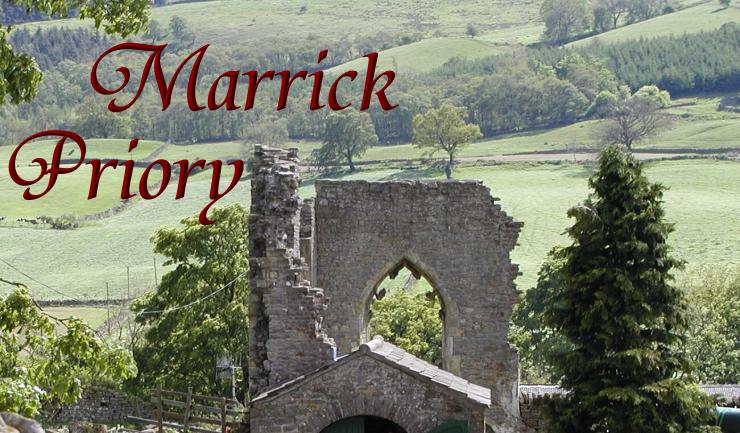
 |
Agnes slept here.
She was Agnes Scrope Boynton Ratcliffe. She was born and grew up at Bolton Castle, which was the Scrope family home. When she was a young woman she married Christopher Boynton [II] and moved to Sedbury, which was the center of the Sedbury Boynton family fortune. Christopher died in a few years, however, and she remarried. She married Richard Ratcliffe and they went off to London to advise Richard III. Three years later Richard Ratcliffe died with Richard III on the battlefield, and Agnes moved back to Sedbury. After Richard's death she retired from married life. She took the veil, a vow of chastity, managed the family fortune and arranged the marriage of her children. After more than a decade, her son Henry was old enough to inherit, was knighted, and was married. So Agnes retired again; this time to Marrick Priory. And Marrick Priory became a Boynton place.
Retiring from the family home seems to have been a tradition. Joan, Agnes' mother in law, had retired to Yarm, her family home, after Agnes and Christopher married. Agnes followed suit.
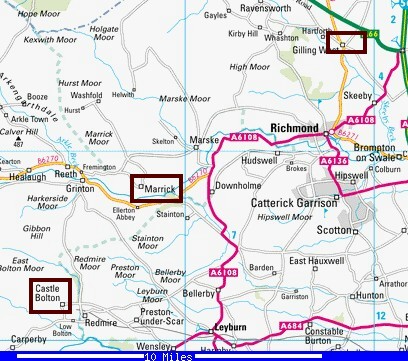 |
What would lead Agnes to choose Marrick Priory? We do not know, of course; we can only speculate. But one speculation seems straightforward. Marrick was approximately half way between her family home in Bolton Castle and Sedbury. On the map Bolton Castle is in the bottom left corner, Marrick is almost in the center, and Sedbury is in the top right corner.The scale indicates the distances between the three locations.
In addition, Agnes knew the Askes very well. They lived down the road only a few miles from Sedbury. The Askes had established Marrick Priory in the middle of the twelfth century and had been its principal supporters ever since. Agnes would enjoy a very special status as a woman of stature as well as guest of the principal supporters of the religious house.
The priory had a good start according to Christopher Clarkson in his history of Richmond, including a section on Marrick Priory, that was published in 1821 [A Boynton Document: Clarkson History]. Marrick manor was held by the Askes. They held it from the earl of Richmond who, in turn, held it from the king. Roger Aske, the founder, got the permission of both to set aside part of the land and tithes from the mill to set up the priory. He also gave the church in Marrick, St. Andrews, to the priory from which they received income. The priory was given other farm lands and they had property in Richmond, which was the trading center for the area. Later in the twelfth century they were given the Hospital of Rerecross. This propitious beginning was not followed by other substantial contributions. In this it was like most of the religious houses for women. Between the twelfth and sixteenth centuries religious houses for men prospered; religious houses for women barely held their own. Henry VIII's economic survey of the religious houses in 1535 showed that two-thirds of the Benedictine houses for women in York had incomes less that £100 a year, but only one-quarter of the houses for men had incomes that small [Tillotson, 1989, p. 2]. There is an irony in Clarkson's account of the sales of the land after the dissolution. The priory that had barely £20 income in 1535 was sold a century later for several thousand pounds.
The priory may not have had prosperity, but it did offer tranquility. After a very public life caught up in the middle of the maelstrom of the Wars of the Roses tranquility probably appealed to Agnes. The priory was nestled into a small green valley.
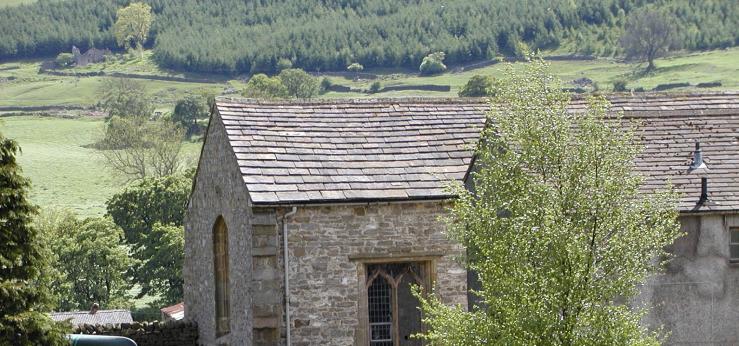 |
It is not rich agricultural land; sheep are a primary product. That may have been part of the prosperity problem. But it is an oasis of green in the middle of brown moors. It is a lovely valley with a stream at the bottom, and an interesting view of the horizon.
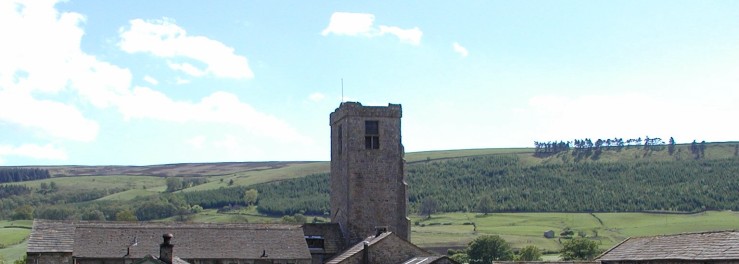 |
There is very little left of the original buildings. The church tower remains even though much of the rest of the building was torn down. The windows above and the wall in the top picture are most of what is left.
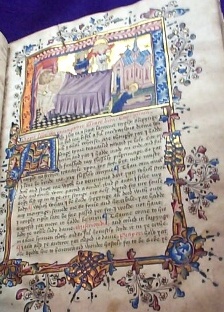 |
When Agnes died she left a gift for the priory -- a book that had been a gift from her father. The title is Pilgrimage of the Soul, and her copy, which is in the New York City Public Library, is one of only fifteen extant copies of the book. It is about a dream pilgrimage, and is deeply religious in theme. In 1990 Rosemarie McGerr published a critical edition of the book that described in depth each copy [A Boynton document: Pilgrimage of the Soul]. The page at the left is an example of the decoration used in copying the book -- by hand, of course.
It is time to become precise about what we know. We know that Agnes presented The Pilgrimage of the Soul to the Priory of Marrick. We know that the priory was established and supported by the Aske family. We can be quite confident that Agnes had established a special relationship with Marrick priory -- else she would not have left the book to the priory. It seems very likely that this special relationship was facilitated by having the Askes as neighbors. Did Agnes retire to the priory? Probably not in the sense we think of retiring. First, it was quite common for priories to accept guests [Tillotson, p. 20] -- though visitations by the church hierarchy to the priories often contained strong language rebuking them for the practice. So it would not have been unusual for Agnes to retire to the priory. However, Agnes and her family and friends were highly mobile. Most of these families had multiple manors and they regularly traveled between them. It seems likely that Agnes would not have stopped traveling. The choice of Marrick made it especially easy to get to the two locations that she was most likely to visit. So Marrick priory was probably one stop on her travels. But we do not know this.
Agnes slept here -- of that we can be quite confident.
Nestled in a small valley in western Yorkshire, Marrick Priory served the religious needs of its neighbors for four centuries. And for one brief moment brought tranquility to a Boynton in need of tranquility.
.....
Clarkson, Christopher (1821) The History of Richmond, in the County of York.
McGerr, Rosemarie Potz, ed. (1990), The Pilgrimage of the Soul; A Critical Edition of the Middle English Dream Vision, Garland Publishing.
Tillotson, John H. (1989) Marrick Priory: A Nunnery in Late Medieval Yorkshire, Borthwick Paper no. 75.
.....
from English Monastic Archives [project] at
http://www.ucl.ac.uk/history/monastic/index.htm
Marrick, Yorks. (North Riding)
Benedictine (or at one time apparently Cistercian) priory, of nuns; dedicated to St Andrew. Founded by Roger de Aske between 1154 and 1158 (and probably before Sept. 1156); dissolved 1539.
Its principal estate was the manor of Marrick; it had other lands in Yorks.
(NR), and the churches of Marrick, `Kerken' (? Carkin, in Forcett, Yorks., N.R.)
and Lund (Yorks., E.R.) [Valor Ecclesiasticus, V, p. 237, where its total income
is given as œ64 18s. 9d.]. It also owned the Rerecross hospital (or Spital
on Stainmoor, in Bowes, Yorks., N.R.) [cf. V.C.H. Yorks., III, pp. 321-2].
Charter of Foundation
1. Hull University Library, DDCA(2)/29/1. See below, s.v. CHARTERS.
Printed: T. S[tapleton?], Collectanea Topographica & Genealogica, v, p.
101, Marrigg no. 1, and cf. ibid., p. 259 n.; Early Yorkshire Charters, ed.
Clay, V, pp. 76-7, no. 173 [dates to 1154x8 and probably to 1154x6].
Charters
2. Hull University Library, Stapleton Family (Lords Beaumont) Family &
Estate Papers DDCA(2)/29/1-121. On deposit since 1978 from M.F.S. Fitzalan-Howard,
17th duke of Norfolk). 121 charters etc.; mid-12th - 16th cent., including the
foundation charter (q.v.). These charters are the greater part of the group
of over 135 that in 1838 belonged to Martin Farquhar Tupper (d.1889), descendant
of a former owner of the priory site and lands; this group evidently had passed
with the ownership of the priory site: see Hull University Library, DDCA(3)/4/1,
schedule of documents relating to the priory, c. 1630, with a note of deeds
transferred on 19 Feb. 1651/2 and another note, 14 Mar. 1693/4, by John Blackburne,
a former owner of the priory.
Five charters were detached from this group not later than 1928, being sold
by Myers & Co., cat. 260, pp. 75-6; they were bought by E.A. Brotherton,
Lord Brotherton of Wakefield (d. 1930), and are now Leeds University Library,
Brotherton Collection, Marrick Priory documents (uncatalogued).
Two 12th-cent. charters and a bond, also from the same group, were sold from
the collection of the dealer Solomon Pottesman (d. 1978) at Sotheby's, 11 Dec.
1979, lot 17 (bought by R.W. Maggett).
Printed: T. S[tapleton?], Collectanea Topographica & Genealogica, v, pp.
100- 24, 221-59 [cal. of Tupper's entire group]; Early Yorkshire Charters, ed.
Clay, IV, no. 53, and V, nos. 125-7, 168, 170-1 and 173-7 [12 charters of the
12th and early 13th cent.].
Customaries, Statutes etc.
3. London, BL, Egerton Ch. 406. Articles for the observance of the nuns, prescribed
after a visitation in 1252.
Lit.: Fallow, V.C.H. Yorks., III, p. 117; Thompson, Women Religious, p. 206.
Provenance: John Gough Nichols (d. 1873); sale of his collection of MSS, Sotheby,
4 (etc.) Dec. 1874, lot 2793 (Quaritch, for the BM).
Estate Records: Rentals, Surveys & Extents
4. Hull University Library, DDCA(2)/29/108, 111, 112 and 113. Rentals of 1416(?), 1457, 1497(?) and 1511.
5. Manchester, John Rylands University Library, Beaumont Ch. 91. Rental made
by prioress, May 1535ÿ.
Provenance: Thomas Stapleton, antiquary (d. 1849); by descent to Baroness Beaumont
of Carlton Towers (Yorks.), by whom sold at Sotheby's, 21-2 Oct. 1920, in lot
228 (Quaritch).
6. Leeds University Library, Brotherton Collection, Marrick Priory documents (uncatalogued). Rental made by prioress, Nov. 1535.
7. London, PRO, Exchequer, Augmentation Office Miscellaneous Books, E315/401,
pp. 217-221. Extracts from rental, 31 Hen. VIII.
Printed: C. Clarkson, History of Richmond, in the County of York (Richmond,
1821), pp. 318-19 [Engl. transln.]; Dugdale, Monasticon, new edn., IV, pp. 246-7,
no. ii [reprinted from Clarkson].
Ground Plan
8. Untraced. Ground plan of the priory church and precinct, headed `The plotte
of the latt priorye of Marrigge'. Undated; datable to between 1539 (dissolution)
and c. 1547 (by when the nave altars would have been removed). The function
of each room or building within the precinct is stated (e.g. `oxe howse', `gatehowse',
`straungers stable').
Illustrated: T. S[tapleton?], Collectanea Topographica & Genealogica, v,
opp. p. 100 [lithographed facsimile]; Gilchrist, Gender and Material Culture,
p. 75, fig. 23 [reproduced from Collectanea Topographica & Genealogica;
with statements of room functions added in modernised English].
Lives of Prioresses
9. Leeds University Library, Brotherton Collection, untraced. 16th- cent.
MS account of the Aske family and the prioresses of Marrick, written in French.
Lit.: J.A. Symington, The Brotherton Library. A Catalogue of Ancient Manuscripts
and Early Printed Books... (Leeds, 1931), p. 10 [mentions as among the Marrick
Priory docts.].
Obedientiaries' Accounts
10. Hull University Library, DDCA (2)/29/108, among the main group of Marrick
charters (q.v. for details). Bursar, sacrist and granger, 1415-16.
Printed: Tillotson, Marrick Priory, pp. 27-35 [Engl. transln.].
Lit.: Tillotson, Marrick Priory, pp. 8-16, 49-50.
Surrender: Deed of Surrender
11. London, PRO, E322/149. Dated 15 Sept. 1539.
The priory had been exempted from dissolution with the other lesser monasteries
by letters patent, 9 Sept. 1536 [L.P. Henry VIII, XI, pt. 2, p. 209, no. 519
(11); cf. Hull University Library, DDCA(2)/29/119].
Printed: L.P. Henry VIII, XIV, pt. 2, p. 51, no. 175 [cal.].
Lit.: 8th Rep. of Deputy Keeper of Public Records (1847), appx. ii, p. 30.
Surrender: Pension-List
12. London, PRO, Exchequer, Augmentation Office, Miscellaneous Books, E315/245,
f. 195r. List of pensions assigned to the former prioress and 12 nuns, 15 Sept.
1539.
Printed: L.P. Henry VIII, XIV, pt. 2, p. 51, no. 175 (2) [cal.].
Bibliography
Janet E. Burton, The Yorkshire Nunneries in the Twelfth and Thirteenth
Centuries, Borthwick Paper no. 56 ([York], 1979).
John Burton, Monasticon Eboracense ... (York, 1758), pp. 269-71.
Dugdale, Monasticon, 1st edn., I, pp. 484-6; new edn., IV, pp.
244-8.
W. Farrer and C.T. Clay, ed., Early Yorkshire Charters, 12 vols.
(privately printed, and then Yorks. Archaeological Soc., Record Ser., Extra
Ser., I-X, 1914-65), vols. IV and V.
T.M. Fallow, `The Priory of Marrick', in V.C.H., Yorkshire, III, pp. 117-18.
Roberta Gilchrist, Gender and Material Culture. The Archaeology
of Religious Women (London and New York, 1994).
T. S[tapleton?], `Ground Plan and Charters of St. Andrew's Priory in the Parish
of Marrigg, North Riding, Co. Ebor.', Collectanea Topographica & Genealogica,
v (1838), pp. 100-24, 221-59.
Tanner, Notitia Monastica, 3rd edn., Yorkshire, no. lxxvii.
Sally Thompson, Women Religious: the Founding of English Nunneries after
the Norman Conquest (Oxford, 1991).
J.H. Tillotson, Marrick Priory: A Nunnery in Late Medieval Yorkshire,
Borthwick Paper no. 75 ([York], 1989).
© G. R. Boynton, September 23, 2002